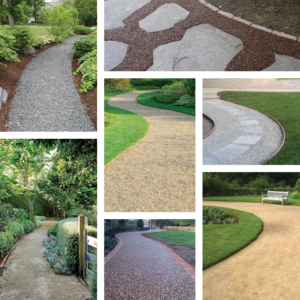Alright, welcome to Part Two of our Creating Pathways That Last series. In our last installment (click here to read), we gave a general overview of pathway construction and posed a number of questions to get you thinking about best practices, general material makeup, challenges to consider, and potential goals (pre and post production) for your unique install.
Today we’ll run through some thoughts and questions that we’ve been presented over our decades of experience in constructing sound pathways with our own Polymer Pavement System product/solution. We hope, in outlining these questions and considerations, that you’ll be better prepared to make a more educated decision on what direction you’d like to take with your project. That said, we’re always available to answer any further questions you may have!
Let’s get started.

Performance testing and soil particle engineering:
Our experience and understanding of soil structure helps us evaluate aggregates for long term pathway traffic. Each sample submitted to our lab goes through a rigorous testing protocol. Proprietary test methods help determine the longevity of an aggregate. In some areas, we can even use this science to engineer aggregates to have the right composition of soil particles.
Are there color options for pathway aggregate?
In some cases aggregate can be chosen for color. Stabilized crushed stone and decomposed granite come naturally in varied colors. Colorations of aggregates are derived from the natural weathering from soil and rock particles in various regions. DirtGlue polymer (binder/stabilizer) does not change the color. This allows the aesthetics of the natural material with the stabilized properties that provide lifespan, low/no maintenance and functionality similar to asphalt or concrete. The natural colors rather than the black of asphalt help minimize the heat island effect.
Will freeze/thaw cycles ruin my stabilized pathway?
In colder climates, when water is present in the soil/aggregate freeze/thaw cycles are a definitely a concern. On properly constructed Polymer Pavement stabilized pathways the effects of freeze/thaw can be eliminated or minimized through proper surface geometry and proper drainage applications. It is common to see cracking with concrete or other rigid pavements because they resist the movement of the cycle unless well drained and properly shaped. Polymer Payment has a very slight amount of flex which eliminates expansion joints.
Will Polymer Pavement damage my plants and trees?
The Polymer Pavement System poses no threat to plants and trees. This technology is non-toxic and can be used right up to the edge of planting areas.
Sustainability/LEED® potential:
Leadership in Energy & Environmental Design (LEED) by The US Green Building Council is a third party verification of green building practices. Pathways of natural aggregates such as decomposed granite, gravel(s), and crushed stone stabilized with the Polymer Pavement System may potentially help earn LEED points towards certification.
Reduced heat island effect/Solar reflectance:
When asphalt surfaces retain heat in an urban environment it is called the Heat Island Effect. Lighter colored aggregates can reflect solar rays reducing the heat retained in the pathway surface. This is measured by the Solar Reflectance Index. Reference – LEED Code- SS 7.1 Heat Island Non-Roof.
Non-hazardous materials:
The Polymer Pavement System puts no VOCs into the air so no air quality issues and no respiratory issues will be experienced. The products used in this technology are non-toxic, and non-hazardous according to US EPA test methods. These products contain no chlorides and no acids (thus, they’re non-corrosive).
Use of local/regional materials:
Aggregates obtained locally for the construction project are considered local/regional materials and can earn points for a reduced carbon footprint. Reference – LEED Code- MR 5 Regional Materials.
Recycled content:
The Polymer Pavement System can be used to stabilize recycled materials such as asphalt or concrete grindings, glass, and even metal scoria. Reference – LEED Code- MR 4 Recycled Content.
Recyclable pathways:
While not a LEED category, aggregate stabilized using the Polymer Pavement System is non-toxic and can be reused in many other areas when its service as a pathway has run its course.
Natural aggregates vs. concrete and asphalt:
Natural pathway materials may not be suitable for every scenario, but neither are concrete and asphalt. Polymer Pavement can meet performance standards required of concrete and asphalt.
Accessibility:
To comply with the Americans with Disabilities Act (ADA), pathways must meet standards for firm, non-slip surfaces. While The National Center on Accessibility (NCA) does not officially approve any product, the Polymer Pavement System can be a recommended natural surface when used in proper design. The Polymer Pavement System can be applied/installed to meet testing requirements for slip friction.
Longevity/Lifespan:
Most natural aggregates vary in durability, but tend to be composed of harder rock particles that can make pathways last for decades with proper design.
Trail potential:
Wilderness trails pose unique requirements on designers and trail builders. Site conditions, including water flow and limited access to water for installation, along with heavy traffic, make these paths a challenge. Polymer Pavement can provide an application that is considered permanent in the same vain that asphalt is considered permanent.
Driveways and parking:
With proper design, the Polymer Pavement System can meet most municipal requirements for driveway and parking surfaces.
Fire lane Support:
With proper design, Polymer Pavement will meet or exceed load bearing requirements needed to support firetrucks and other rescue vehicles.
These are all but a handful of things to consider when you’re plotting your impending pathway project. Give us a shout if you’d like a helping hand or have any further questions that we can answer for you!
GES: For the earth, with the earth in mind.






